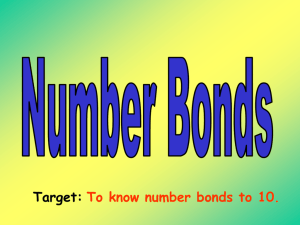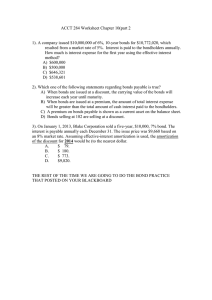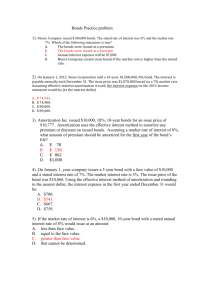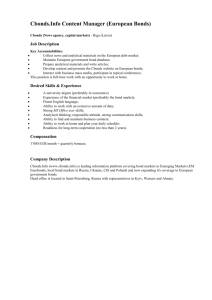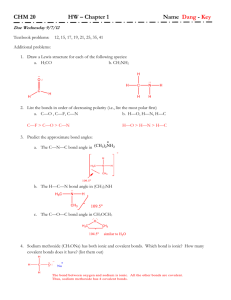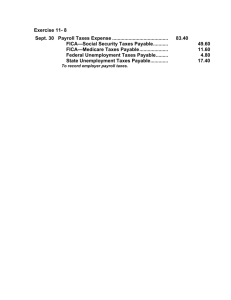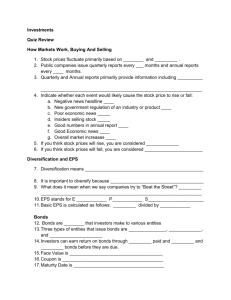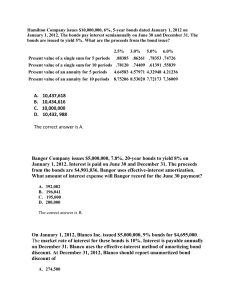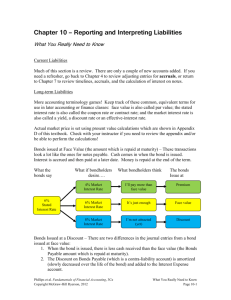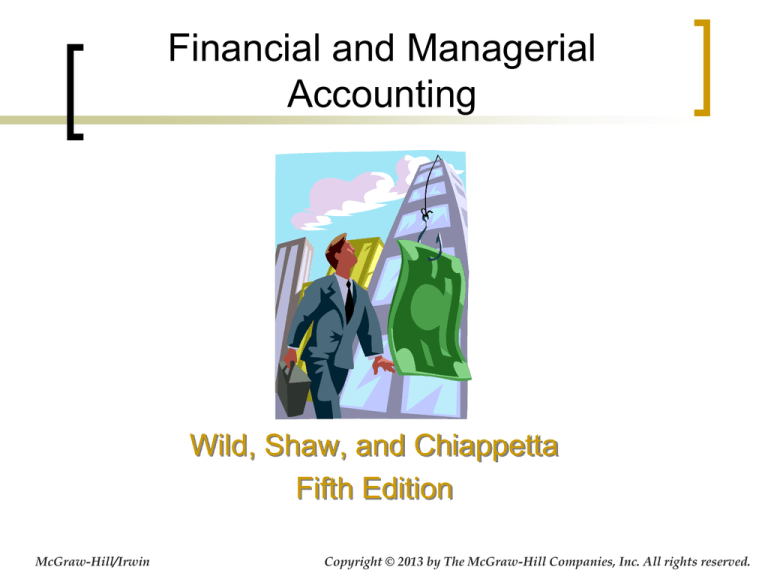
Financial and Managerial
Accounting
Wild, Shaw, and Chiappetta
Fifth Edition
McGraw-Hill/Irwin
Copyright © 2013 by The McGraw-Hill Companies, Inc. All rights reserved.
Chapter 10
Long-Term Liabilities
Conceptual Learning Objectives
C1: Explain the types and payment patterns of
notes.
C2: Appendix 10A – Explain and compute the
present value of an amount(s) to be paid at
a future date(s).
C3: Appendix 10C – Describe interest accrual
when bond payment periods differ from
accounting periods.
C4: Appendix 10D – Describe accounting for
leases and pensions (see text for details).
10-3
Analytical Learning Objectives
A1: Compare bond financing with stock
financing.
A2: Assess debt features and their
implications.
A3: Compute the debt-to-equity ratio and
explain its use.
10-4
Procedural Learning Objectives
P1: Prepare entries to record bond
issuance and interest expense.
P2: Compute and record amortization of
bond discount using straight-line method.
P3: Compute and record amortization of
bond premium using straight-line method.
P4: Record the retirement of bonds.
P5: Prepare entries to account for notes.
P6: Appendix 10B- Compute and record
amortization of bond discount using effective
interest method.
P7: Appendix 10B- Compute and record
amortization of bond premium using effective
interest method.
10-5
A1
Advantages of Bonds
Bonds do not affect
owner control.
Interest on bonds is
tax deductible.
Bonds can increase
return on equity.
10-6
A1
Disadvantages of Bonds
Bonds require payments of both
periodic interest and par value at
maturity.
Bonds can decrease return on
equity when the company pays
more in interest than it earns on
the borrowed funds.
10-7
A1
Bond-Issuing Procedures
A company can sell
the bonds to
. . . investors
. . .an investment firm
called an underwriter,
resells the bonds to
A trustee
monitors
the bond
issue.
10-8
A1
Basics of Bonds
Bond Interest Payments
Corporation
Investors
Bond Interest Payments
Bond Issue
Date
Interest payment =
Bond par value Contract interest rate x
Time
10-9
P1
Issuing Bonds at Par
King Co. issues the following bonds on
January 1, 2013
Par value = $1,000,000
Stated interest rate = 10%
Interest dates = 6/30 and 12/31
Bond date = Jan. 1, 2013
Maturity date = Dec. 31, 2032 (20 years)
Jan. 1
DR
1,000,000
Cash
Bonds Payable
CR
1,000,000
Issued bonds at par
10-10
P1
Interest Expense on Bonds at Par
The entry on June 30, 2013, to record the
first semiannual interest payment is . . .
June 30
Bond Interest Expense
Cash
DR
50,000
CR
50,000
Paid semiannual interest
Interest payment is: $1,000,000 × 10% × ½ year = $50,000
This entry is made every six months until the
bonds mature.
10-11
P1
Issuing Bonds at Par
On Dec. 31, 2032 when the bonds mature,
King Co. makes the following entry . . .
Dec. 31
Bonds Payable
Cash
DR
1,000,000
CR
1,000,000
Paid bond principal at maturity
The debt has now been
extinguished.
10-12
P1
Bond Discount or Premium
Contract rate is:
Bond sells:
Above market rate
At a premium
Equal to market rate At par value
Below market rate
At a discount
Contract rate
Dow Chemical Company
$1,000
8.875% paid semiannually on 6/30 and 12/31
Due (matures) on 2033
10-13
P2
Issuing Bonds at a Discount
Prepare the entry for Jan. 1, 2013, to record the
following bond issue by Rose Co.
Par value = $1,000,000
Issue price = 92.6405% of par value
Stated interest rate = 10%
Bond will sell at a discount.
Market interest rate = 12%
Interest dates = 6/30 and 12/31
Bond date = Jan. 1, 2013
Maturity date = Dec. 31, 2017 (5 years)
}
10-14
P2
Issuing Bonds at a Discount
Par Value
$1,000,000
Cash
Proceeds
Discount
- $ 926,405 = $ 73,595
$1,000,000 92.6405%
Amortizing the discount increases interest
expense over the outstanding life of the bond.
10-15
P2
Issuing Bonds at a Discount
On Jan. 1, 2013, Rose Co. would record
the bond issue as follows:
Jan. 1
Cash
Discount on Bonds Payable
Bonds Payable
DR
926,405
73,595
CR
1,000,000
Sold bonds at a discount on issue date
Bonds Payable
1,000,000
Discount on
Bonds Payable
73,595
Contra-Liability
Account
10-16
P2
Making the First Interest Payment
and Amortizing the Discount
Partial Balance Sheet as of Jan. 1, 2013
Long-Term Liabilities:
Bonds Payable
Less: Discount on Bonds Payable
$ 1,000,000
73,595
$ 926,405
Maturity
Value
Using the straight-line method, the
discount amortization will be $7,360
every six months.
Carrying
Value
$73,595 ÷ 10 periods = $7,360*
*(rounded)
10-17
P2
Making the First Interest Payment
and Amortizing the Discount
Make the following entry every six months
to record the cash interest payment and the
amortization of the discount.
June 30
Bond Interest Expense
Discount on Bonds Payable
Cash
DR
57,360
CR
7,360
50,000
Paid semiannual interest and amortized discount
$73,595 ÷ 10 periods = $7,360 (rounded)
$1,000,000 × 10% × ½ = $50,000
10-18
Straight-Line Amortization
of Bond Discount
P2
Date
1/1/2013
6/30/2013
12/31/2013
6/30/2014
12/31/2014
6/30/2015
12/31/2015
6/30/2016
12/31/2016
6/30/2017
12/31/2017
Straight-Line Amortization Table
Interest
Interest
Discount Unamortized Carrying
Payment
Expense Amortization* Discount
Value
$
73,595 $ 926,405
$ 50,000 $ 57,360 $
7,360
66,235
933,765
50,000
57,360
7,360
58,875
941,125
50,000
57,360
7,360
51,515
948,485
50,000
57,360
7,360
44,155
955,845
50,000
57,360
7,360
36,795
963,205
50,000
57,360
7,360
29,435
970,565
50,000
57,360
7,360
22,075
977,925
50,000
57,360
7,360
14,715
985,285
50,000
57,360
7,360
7,355
992,645
50,000
57,355
7,355
0 1,000,000
$ 500,000 $ 573,595 $
73,595
* Rounded.
10-19
Straight-Line and Effective
Interest Methods
P2
Periodic interest amounts will differ but
total interest expense, over the life of the
bond, will be the same.
60,000
59,000
$
Straight-Line Method
58,000
57,000
56,000
Effective Interest Method
55,000
54,000
12/31/2008
12/31/2009
12/31/2010
LifeMethod
of the Bond
Straight-Line
57,360
57,360
57,360
Effective Interest Method
55,919
56,650
57,472
10-20
P3
Issuing Bonds at a Premium
Prepare the entry for Jan. 1, 2013, to record the
following bond issue by Rose Co.
Par value = $1,000,000
Issue price = 108.1145% of par value
Stated interest rate = 10%
Bond will sell at a premium.
Market interest rate = 8%
Interest dates = 6/30 and 12/31
Bond date = Jan. 1, 2013
Maturity date = Dec. 31, 2017 (5 years)
}
10-21
P3
Issuing Bonds at a Premium
Cash
Proceeds
Par Value
Premium
$1,081,145 - $ 1,000,000 = $ 81,145
$1,000,000 108.1145%
Amortizing the premium decreases
interest expense over the life of the
bond.
10-22
P3
Issuing Bonds at a Premium
On Jan. 1, 2013, Rose Co. would record
the bond issue as follows.
DR
Jan. 1
Cash
CR
1,081,145
Premium on Bonds Payable
Bonds Payable
81,145
1,000,000
Issued bonds at a premium on issue date
Bonds Payable
1,000,000
Premium on
Bonds Payable
81,145
Adjunct-Liability
(or accretion)
Account
10-23
P3
Making the First Interest Payment
and Amortizing the Bond Premium
Partial Balance Sheet as of Jan. 1, 2013
Long-Term Liabilities:
Bonds Payable
Add: Premium on Bonds Payable
Using the straight-line method,
the premium amortization will
be $8,115 every six months.
$81,145 ÷ 10 periods = $8,115
(rounded)
DR
$ 1,000,000
81,145
CR
$ 1,081,145
Maturity
Value
Carrying
Value
10-24
P3
Making the First Interest Payment
and Amortizing the Bond Premium
This entry is made every six months to
record the cash interest payment and the
amortization of the premium.
June 30
Bond Interest Expense
Premium on Bonds Payable
Cash
DR
41,885
8,115
CR
50,000
Paid semiannual interest and amortized premium
$81,145 ÷ 10 periods = $8,115 (rounded)
$1,000,000 × 10% × ½ = $50,000
10-25
Straight-Line Amortization
of Bond Premium
P3
Date
1/1/2013
6/30/2013
12/31/2013
6/30/2014
12/31/2014
6/30/2015
12/31/2015
6/30/2016
12/31/2016
6/30/2017
12/31/2017
Straight-Line Amortization Table
Interest
Interest
Premium Unamortized Carrying
Payment Expense Amortization* Premium
Value
$
81,145 $ 1,081,145
$ 50,000 $ 41,885 $
8,115
73,030
1,073,030
50,000
41,885
8,115
64,915
1,064,915
50,000
41,885
8,115
56,800
1,056,800
50,000
41,885
8,115
48,685
1,048,685
50,000
41,885
8,115
40,570
1,040,570
50,000
41,885
8,115
32,455
1,032,455
50,000
41,885
8,115
24,340
1,024,340
50,000
41,885
8,115
16,225
1,016,225
50,000
41,885
8,115
8,110
1,008,110
50,000
41,890
8,110
0
1,000,000
$ 500,000 $ 418,855 $
81,145
* Rounded.
10-26
P4
Bond Retirement
The carrying value of the bond at maturity
always equals its par value.
Sometimes bonds are retired prior to their
maturity.
Two common ways to retire bonds before
maturity are through the exercise of a
callable option or through purchasing them
on the open market.
Callable bonds present several accounting
issues including calculating gains and
losses.
10-27
P4
Bond Retirement
Dec. 31
Bonds Payable
Cash
DR
1,000,000
CR
1,000,000
Retirement of bonds at maturity
•
Before Maturity
•
•
Carrying value > Retirement price = Gain
Carrying value < Retirement price = Loss
10-28
C1
Long-Term Notes Payable
Cash
Company
Note Payable
Lender
When is the repayment of the principal
and interest going to be made?
Note Issuance Date
Note Maturity
Date
10-29
C1
Long-Term Notes Payable
Single Payment of
Principal plus Interest
(at maturity)
Company
Lender
Single Payment of
Principal plus
Interest
Note Issuance
Date
Note Maturity
Date
10-30
C1
Long-Term Notes Payable
Regular Payments of
Principal plus Interest
(Over the life of the bond)
Lender
Company
Regular Payments of Principal plus Interest
Note
Issuance
Date
Payments can either be
equal principal payments
plus interest or equal
payments.
Note Maturity
Date
10-31
Installment Notes with Equal
Principal Payments
C1, P5
Annual
payments
decrease.
$16,000
$14,000
$12,000
$10,000
Interest
Principal
$8,000
$6,000
$4,000
$2,000
$Year 1 Year 2 Year 3 Year 4 Year 5 Year 6
The principal payments are $10,000 each year.
Interest expense decreases each year.
10-32
Installment Notes with Equal
Payments
C1
Annual
payments
are constant.
$14,000
$12,000
$10,000
$8,000
Interest
Principal
$6,000
$4,000
$2,000
$Year 1 Year 2 Year 3 Year 4 Year 5 Year 6
The principal payments increase each year.
Interest expense decreases each year.
10-33
P5
Mortgage Notes and Bonds
A legal agreement that helps protect the
lender if the borrower fails to make the
required payments.
Gives the lender the right to be paid out of the
cash proceeds from the sale of the borrower’s
assets specifically identified in the mortgage
contract.
10-34
A2
Types of Bonds
Secured or
Unsecured
Convertible
and/or
Callable
Term or
Serial
Registered or
Bearer
10-35
A3
Debt-to-Equity Ratio
Debt-toEquity ratio
Total liabilities
=
Total equity
A measure to assess the risk of a company’s
financing structure.
Industries that are more variable and less stable
tend to have lower ratios, while more stable
industries tend to have higher ratios.
10-36
C2
Figuring the
Present Value of a Bond
Calculate the issue price of Rose Co.’s bonds.
Par value = $1,000,000
Issue price = ?
Stated interest rate = 10%
Market interest rate = 12%
Interest dates = 6/30 and 12/31
Bond date = Jan. 1, 2013
Maturity date = Dec. 31, 2017 (5 years)
10-37
C2
Figuring the
Present Value of a Bond
Cash Flow
Par value of the bond
Interest (annuity)
Table
PV of $1
PV of an
Annuity of $1
Table
Present
Value
Amount
Value
0.5584 $ 1,000,000 $ 558,400
7.3601
50,000
Price of bond
368,005
$ 926,405
1. Semiannual rate = 6% (Market rate 12% ÷ 2)
2. Semiannual periods = 10 (Bond life 5 years × 2)
$1,000,000 × 10% × ½ = $50,000
10-38
P6, P7
Effective Interest Method of
Amortizing a Discount or Premium
The effective interest method allocates total
bond interest expense over a changing
carrying value. It yields a constant rate of
interest over the life of the bond equal to the
market rate at time of issuance.
Carrying Value of the bond x Market Rate x Time
10-39
Issuing Bonds between
Interest Dates
C3
Jan. 1, 2013
Bond Date
Apr. 1, 2013
Bond Issue
Date
June 30, 2013
First Interest
Payment
Accrued interest
Investor pays bond purchase
price + accrued interest.
10-40
Issuing Bonds between
Interest Dates
C3
Jan. 1, 2013
Bond Date
Apr. 1, 2013
Bond Issue
Date
Accrued interest
June 30, 2013
First Interest
Payment
Earned
interest
Investor
receives 6
months’
interest.
10-41
C3
Issuing Bonds between
Interest Dates
Prepare the entry to record the following bond
issue by King Co. on Apr. 1, 2013.
Par value = $1,000,000
Stated interest rate = 10%
Market interest rate = 10%
Interest dates = 6/30 and 12/31
Bond date = Jan. 1, 2013
Maturity date = Dec. 31, 2017 (5 years)
Issue price of bonds
Accrued interest
$1,000,000 × 10% × 3/12 =
Total cash received
$ 1,000,000
25,000
$ 1,025,000
10-42
Issuing Bonds between
Interest Dates
C3
At the date of issue, the following entry is made:
Apr. 1
DR
1,025,000
Cash
Interest Payable
Bonds Payable
CR
25,000
1,000,000
Issued bonds at par plus accrued interest
The first interest payment on June 30, 2013 is:
June 30
Interest Payable
Bond Interest Expense
Cash
DR
25,000
25,000
CR
50,000
Paid semiannual interest
10-43
C3
Accruing Bond Interest Expense at Year
End for a Partial Bond Interest Period.
Jan. 1
End of
accounting
Interest Payment Dates
period
Apr. 1
Oct. 1
Dec. 31
3 months’
accrued interest
At year-end, an adjusting entry is necessary
to recognize bond interest expense accrued
since the most recent interest payment.
10-44
End of Chapter 10
10-45

